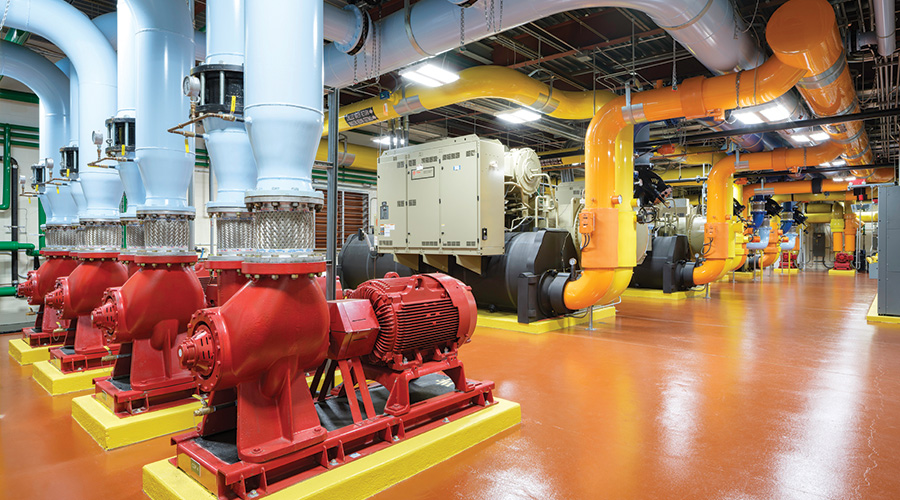Bringing Systems Together
Interoperable LonMark-based systems are helping to drive the convergence of building and IT systems
Convergence, sometimes referred to as “information convergence,” is becoming a buzzword among technically savvy facilities executives as they attempt to shave costs and increase the benefits of building automation systems. Convergence means that information from the building automation system is being brought into the facility’s enterprise and other information technology (IT) backbones, often relying on Internet servers and some IT-based open standards.
Convergence can mean reduced installation and operating costs, more dependable service and new opportunities for interaction between facilities executives and their peers in IT.
Advances in building automation systems, specifically in the areas of connectivity and interoperability, are playing a leading role in the convergence of facilities and enterprise information.
“Integration goes beyond simply having one subsystem exchange information at a user interface level with another sub-system,” says LonMark International executive director Ron Bernstein. “It is the convergence of data transfer and usage from the lowest level, or what we call the device level, all the way to back office enterprise applications that can help define the system control criteria.” Bernstein refers to this convergence as the LON-LAN-WAN infrastructure, where information from LON devices can send and receive information, in a LonMark standard way, from any part of the system without proprietary gateways or drivers.
LonMark International has been a driving force behind gains in interoperability. With more than 350 member companies worldwide, LonMark International is committed to open, interoperable systems using ANSI/CEA 709.1 and related standards. “LonMark continues to be the worldwide standard for delivering truly open, multivendor, integrated systems,” says LonMark executive director Ron Bernstein. LonMark has affiliates in the Americas, Asia and Europe.
Part of LonMark International’s mission is to help people take advantage of open, integrated systems, says Bernstien. “To ensure that all elements of a building’s control environment can share information, standards are needed to allow data to flow between them without requiring significant custom engineering at the integration level.”
The concept of convergence — where different forms of information such as data, voice, audio and control come together in what Reza S. Raji of Echelon Corporation, which created the LonWorks platform, refers to as a “network of networks” — began in the late 1990s and early part of this century. That’s when the World Wide Web Consortium (W3C.org), worked on a method to allow applications from various different vendors to communicate using either the web or wide area networks (WANs). Eventually, W3C.org developed SOAP (simple object access protocol). SOAP was platform-independent — that is, it didn’t require a specific platform because it was built using XML (Extensible Markup Language). SOAP eventually became known as “web services.”
Facility Applications
These IT developments made their way into facility applications. For example, one systems integration firm, Western Allied, approached several of its clients with the idea of using an Internet server which would allow users to read or write to any variable on the control network side. “All were receptive,” says Alan Slabodkin, systems integrator with Western Allied. “Soon it became apparent that this could allow a very simple bridge between the networks, and the possible applications started to appear.” Western Allied has used SOAP to present data on a Web page, to permit writing back to a control network and to pass data between control networks. SOAP also is being used for after-hours control systems, trending and logging utilities, alarm dialers/notifiers, work order systems, security systems, energy analysis, demand control/peak pricing and remote monitoring.
Creating Efficiencies
Kenmark Real Estate Group has also embraced LonMark products to achieve convergence in its owned and managed properties, says Mark Kendall, president. “Once converted to a LonWorks protocol, formerly standalone controls for such systems as HVAC, lighting, security, irrigation and elevators are converged into one building-wide Kenmark IT network.”
The systems are then integrated into Kenmark’s Building Operation Center (BOC). “BOC enables us to converge and consolidate management reporting, maintenance records management, energy management objectives, tenant requests for service processing and building automation controls onto one seamless Web-based platform,” Kendall says. “In doing so, we created efficiencies with better reporting, improved equipment maintenance and PM scheduling, lower utility costs and faster response times to tenant requests for services.”
Though blending such diverse systems might seem intimidating to the uninitiated, Kendall says his experience shows that the convergence of IT and building controls with basic management tools and software need not be difficult. “As we gained more self-reliance and in-house expertise with LonWorks controls, we were able to reach out to other real estate software and IT applications and holistically address our needs for the storage, recovery, control and flow of information throughout a building-wide IT network.”
The converged systems work well. “Our managers, engineers, partners and owner representatives can access virtually every type of property or information onsite and remotely,” he says. “This enables our real estate team members to support one another from virtually anywhere in the world and keeps the time we spend accessing, interpreting and transmitting basic building information to a minimum.”
Road to Convergence
When it comes to convergence, Singapore Management University (SMU) is a beacon to other educational facilities. SMU took over the Bukit Timah campus, which once was the National Institute of Education, in 2001. The campus began as an arts and sciences college in 1929, and many of the basic building systems were outdated.
The office of facilities management needed to overhaul the 12 main buildings to be ready for students, faculty and staff within eight months. Included in this $35 million project was a building system management solution that would deliver both efficiency and ease of use for managing air-conditioning and mechanical ventilation, as well as lighting, fire alarms, security and the centralized chillers used for the campus-wide distributed cooling system. Ho Thim Seng, director of facilities management at SMU, sought to rely on convergence to minimize the cost of integration and provide scalability and flexibility for growth.
LonWorks networks provide highly scalable, peer-to-peer communication between devices, so the need for additional cabling was eliminated, substantially reducing wiring and labor cost. In addition, SMU was able to maximize its investment in its IT infrastructure by using a portion of the university’s Ethernet bandwidth for communication between LonWorks devices spread across the 27-acre campus.
The new building management system includes 1,300 nodes with 35 LonWorks routers, 10 LonWorks Internet servers and 580 LonWorks-compatible controllers.
The university’s LonWorks network operating system has an industrial-standard SCADA (supervisory control and data acquisition) graphical user interface that provides staff with detailed information. Using the university’s Ethernet backbone, each component of the building automation system (BAS) can be accessed from any workstation on campus. Managing the network with the LonWorks network operating system maximizes BAS accessibility and reduces workload by automating common system tasks and handling directory management and routing of services. Personnel can check alarms, display energy management trends and make setpoint adjustments without having to travel to the component.
“The system allows my staff and me to be at different locations on campus and pull up a Web page from a laptop to adjust temperature, scheduling and power supply presets,” Ho Thim Seng says. The system also can page personnel when an alarm sounds.
In the United States, the University of North Carolina at Chapel Hill is integrating the campus control system into its IT backbone using open standards such as Web services and XML. According to George Huettel, president of Cyrus Technologies, a LonMark Associate, the project will incorporate emerging standards such as oBIX as they are finalized. oBIX (the Open Building Information Exchange) is an industry-wide initiative to develop guidelines for use of XML and Web services by building systems. The oBIX technical committee is chaired by Toby Considine, UNC Chapel Hill’s IT manager.
Range of Applications
The concept of convergence benefits many building types. A good example is LTU Arena, a multipurpose stadium in Dusseldorf, Germany, that holds 61,000 spectators. The owners wanted a building that would keep visitors comfortable and operating costs manageable, with automated systems that would be easy to implement. The solution is a convergence of multiple systems over the building’s IT backbone.
Converging the LonWorks-based HVAC, lighting and control network infrastructure are two intranet-enabled building automation system servers equipped with a redundant power supply unit. The network is divided among five LonWorks network operating system databases. Information travels on a fiber optic Ethernet backbone, and Internet protocol routers connect LonWorks FTT 10 components with the IT network. The arena is controlled and monitored through 20 technical centers. Operators can access all data points via LAN or WAN.
More than 80 LonWorks digital controls, with the capacity to add 10 additional modules, manage the facility.
In central Tokyo, NTT Data Shinagawa is a thoroughly modern high-rise office building that has converged all communications facilities in the 30-story structure, including control and operations systems, monitoring and Internet protocol telephony into a single network. The building automation system is based on NTT Data’s technology and disperses existing backbone functions among multiple servers, allowing the network to accommodate large systems. By using Java, Web screens and XML to build systems, the company improved the network’s expandability. And because systems are not operating-system-dependent, there are cost savings as well.
The BAS is linked to an energy management system that reports detailed, benchmarked energy data from each floor. The energy management system performs comprehensive analyses and makes improvements and adjustments.
NTT Data’s security system uses LonWorks technology to monitor the status of locks on all floors. The system provides historical access data and, through its convergence with the IT network, can turn off lights and air conditioning once the last person who leaves operates the card reader. The security system also provides automatic lighting with passive sensors and lighting equipment. An Internet protocol camera permits video monitoring and is linked to the integrated LAN.
As that example shows, open control systems and the convergence of the BAS and IT have economic benefits. “An open, integrated facility that requires and enforces an open systems standard will have a lower installation cost and a significantly lower life-cycle cost,” says Bernstein. “By encouraging multiple competitive bidders to support an open standard and ensuring systems within a facility can openly communicate, facilities executives can ensure basic cross-system functionality, which will reduce operational costs.”
Whether applied to a high-rise office building in Tokyo or a university campus in North Carolina, convergence of building automation systems and subsystems with IT enterprise backbones are creating new opportunities for interoperability that yield cost savings and increased operating efficiencies.
Specifying Open Systems
Too often, system suppliers and integrators will attempt to lock a customer into a seemingly open system by holding back crucial components or implementing less than open products, tools or architectures. To help understand and evaluate how open a solution is, says Ron Bernstein, executive director of LonMark International, ask questions in the following ten areas. They get at the core issues of system and product selection.
- Can the devices from different manufacturers be installed and commissioned on the same physical wire and be capable of true peer-to-peer communication?
- Have the devices been tested for interoperable compliance? Are the manufacturers of the devices adhering to interoperable standards when designing and delivering their products? And are there any closed aspects of these products that would inhibit an open system in which they are intended to be used?
- Is the integrator meeting the requirements for the network infrastructure?
- Are there network management and commissioning tools available from multiple sources that can completely install all the nodes in the system?
- Are the front-end tools open?
- What are the qualifications of the integrator working on the building?
- Are configuration tools, installation tools, plugins, databases and software owned by the vendor or the facilities organization?
- How are devices connected to the data network?
- What controls are being used?
- What testing has been done to show that the network was designed and installed correctly?
|
About LonMark International
From end-users to system integrators to manufacturers, LonMark International has attracted a diverse membership by focusing on a straightforward mission: helping to smooth the way to integration of multi-vendor systems using LonWorks networks.
Open, interoperable systems provide many benefits to end-users. Instead of being locked in to a single vendor for service contracts, end-users can choose products and systems from a range of companies. That helps end-users achieve important goals: controlling costs and selecting the products that best meet the needs of a given application.
Thousands of companies are using LonWork-based products; millions of LonWorks devices have been installed around the world.
A key to LonMark’s efforts to drive open systems is its certification programs for products and systems. A LonMark-certified product has been verified to conform to LonMark Interoperability Guidelines and has been designed to interoperate across a LonWorks network. These products are eligible to carry the LonMark logo. A LonMark Open System is one that meets the criteria laid out in a system definition developed by the organization. LonMark recently launched a new program to test and certify installers, professionals, and integrators of LonMark Open Systems.
Click for more about LonMark International.
|
Related Topics:











